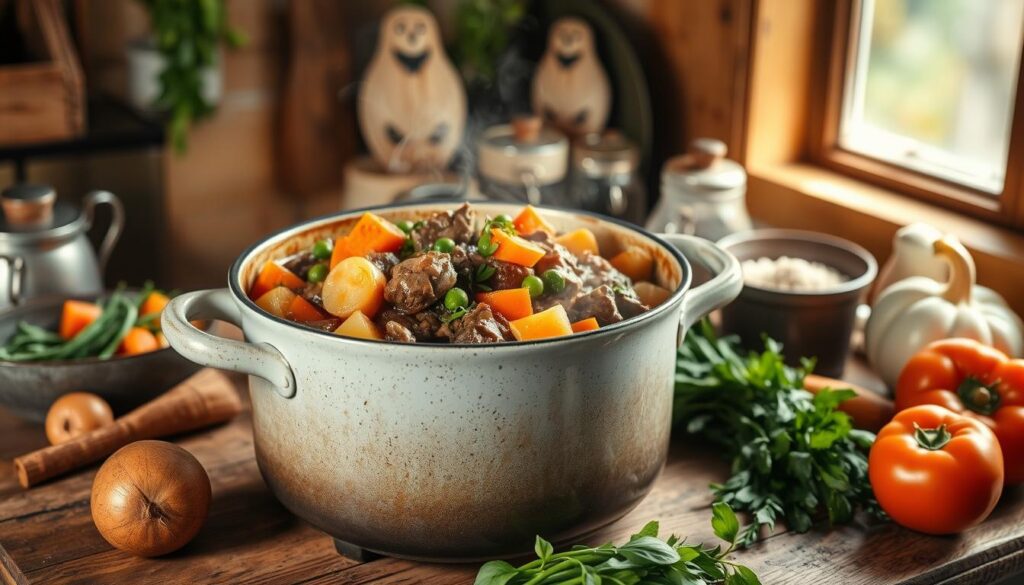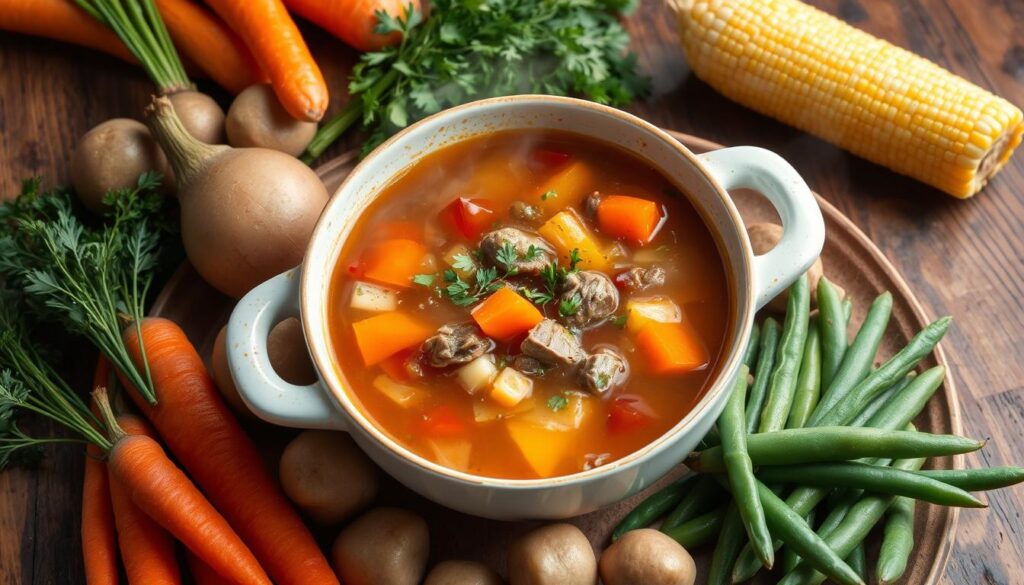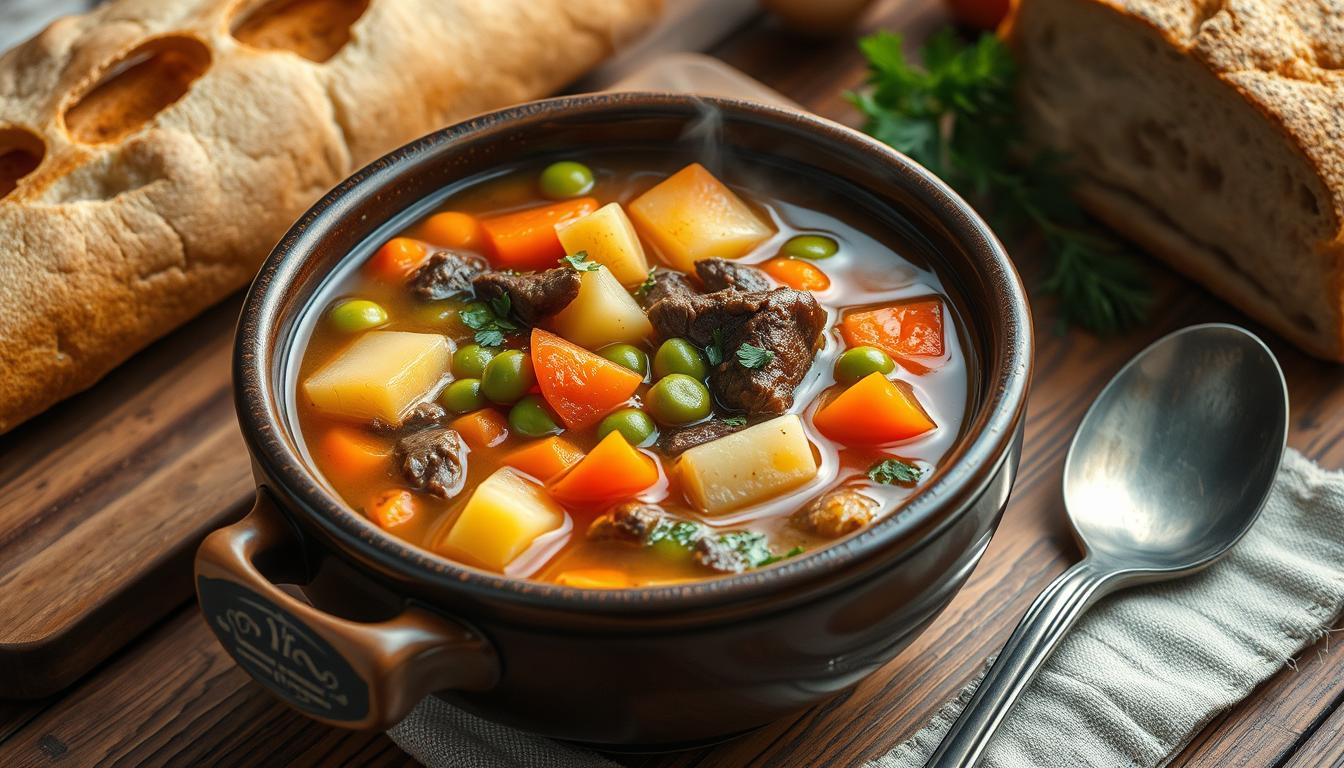5 Steps to Perfect Old Fashioned Vegetable Beef Soup
As the cool autumn breeze whispers through the trees, I crave the comforting aroma of homemade old fashioned vegetable beef soup recipe. This dish, rooted in American farmhouse cooking, takes me back to my grandma’s cozy kitchen. There, the simmering broth and tender beef filled the air, promising a nourishing meal.
If you’re like me, you know the joy of savoring this hearty soup. From the first spoonful to the last, it warms the soul and brings back cherished memories. Today, I’m excited to share the 5 simple steps to making the perfect old fashioned vegetable beef soup in your own kitchen.
Table of Contents
Key Takeaways
- Discover the history and origins of the classic vegetable beef soup
- Learn the essential ingredients for a truly authentic flavor
- Explore the best cuts of beef and proper preparation techniques
- Understand the benefits of using fresh versus frozen vegetables
- Uncover the secrets to mastering the perfect old-fashioned soup recipe
The History Behind Traditional Vegetable Beef Soup
The roots of classic vegetable beef soup go back to early American farmhouse cooking. This dish has changed over time, adapting to new tastes and ingredients. Yet, it still keeps its traditional flavors.
Origins in American Farmhouse Cooking
The classic vegetable beef stew was a key dish for early American settlers. It was a hearty meal that helped them through their hard work. Families used it to make the most of local produce and meat.
Evolution Through Generations
Grandma’s vegetable beef soup recipe has been passed down through families. Each generation added their own twist to the dish. This shows how cooking has changed over time.
“Vegetable beef soup has always been a comforting and satisfying meal in our family, a tradition that has been carried on for as long as I can remember.”
Changes like fresh herbs, different vegetables, and new cooking methods have kept the soup popular. It remains a beloved dish in American cuisine.

Essential Ingredients for Classic Vegetable Beef Soup
Making the perfect old-fashioned beef and vegetable soup needs careful picking of key ingredients. The choice of beef and vegetables is crucial. Each part adds to the soup’s flavor and texture. Let’s look at what makes this classic dish so loved.
The soup’s heart is the beef, like chuck roast, brisket, or short ribs. These cuts, when slow-cooked, give a rich, beefy taste. Alongside, fresh veggies like carrots, onions, celery, and potatoes add their own taste and texture.
- Beef (chuck roast, brisket, short ribs)
- Carrots
- Onions
- Celery
- Potatoes
- Garlic
- Tomatoes (fresh or canned)
- Herbs (thyme, bay leaves, parsley)
- Spices (black pepper, salt, paprika)
Garlic, tomatoes, and herbs and spices add to the soup’s flavor. Together, they make a perfect mix that captures the spirit of traditional vegetable beef soup.
“The key to a truly exceptional vegetable beef soup lies in the thoughtful selection and balance of its ingredients.”
Knowing how each ingredient works lets you make a soup that’s not just tasty but also brings back memories of home-cooked meals.

Selecting and Preparing the Perfect Beef Cuts
Making an old fashioned vegetable beef soup recipe or a hearty vegetable beef soup needs the right beef cuts. The secret to a rich, flavorful broth is choosing the best cuts and preparing them well.
Best Cuts for Soup Making
The best beef cuts for these soups are those that cook well over time. Some top choices include:
- Chuck roast: This cut from the shoulder area is known for its tenderness and flavor when simmered in a soup.
- Short ribs: The fatty texture of short ribs makes them perfect for slow cooking, becoming very tender.
- Brisket: Another tough cut that becomes tender and flavorful when slow-cooked in a soup.
Proper Meat Preparation Techniques
It’s important to prepare the beef right for the best texture and flavor in your soup. Here’s how:
- Trim any excess fat from the beef cuts, leaving just a thin layer to enhance the flavor.
- Cut the beef into bite-sized cubes or strips, ensuring even cooking throughout the soup.
- Pat the beef dry with paper towels to remove any excess moisture, which can prevent proper browning.
Seasoning Your Beef
Seasoning the beef is the last step for a delicious soup. Season the beef with salt, pepper, and any other spices you like, like garlic powder or onion powder. This will give the soup a rich, savory taste.

By choosing the right beef cuts, preparing them well, and seasoning them perfectly, you’ll make a truly exceptional soup.
Fresh vs. Frozen Vegetables: Making the Right Choice
Choosing between fresh and frozen vegetables is key for a great homemade vegetable beef soup. Knowing the benefits of each can help you make a better choice. This will improve your soup-making skills.
Fresh vegetables add a vibrant texture and natural flavors that go well with beef. They’re at their best during certain seasons. But, finding fresh produce all year can be hard.
Frozen vegetables are easy to find and keep well, no matter the season. They’re frozen quickly to save their taste and nutrients. This makes them a good pick when fresh veggies are hard to find.
When picking veggies for your soup, think about the season and flavors that match the beef. Mixing fresh and frozen veggies can make your soup taste amazing.
“The secret to a truly exceptional homemade vegetable beef soup lies in the perfect balance of fresh and frozen produce.”
Whether to use fresh or frozen veggies for your soup depends on what you like, what’s available, and the taste you want. By considering these factors, you can choose wisely. This will lead to a tasty and fulfilling winter vegetable beef soup.

Old Fashioned Vegetable Beef Soup Recipe
Enjoy the cozy taste of a classic vegetable beef stew with this recipe. It’s a family favorite that brings together tender beef and fresh veggies in a delicious broth.
Traditional Cooking Methods
We’ll use old-school stovetop cooking to make this dish. Brown the beef cubes in batches for a tasty crust. Next, add onions, carrots, and celery to mix their flavors. Then, let the soup simmer slowly to bring out the best taste.
Time-Tested Tips and Tricks
- Use a mix of beef chuck and beef shanks for tender and tasty meat.
- Sear the beef in small batches for a nice brown crust.
- Use red wine or beef broth to get every flavor from the pan.
- Simmer the soup for 2 hours to make the veggies tender and flavors rich.
Adjusting Seasonings
Make the seasoning just right for you. Start with salt and black pepper, then add fresh herbs, garlic, and Worcestershire sauce. Keep tasting and adjusting until it’s perfect.
“This vegetable beef soup is the ultimate comfort food – it warms the soul and satisfies the senses with every spoonful.”
Slow Cooker vs. Stovetop Methods
Choosing the right method for making slow cooker vegetable beef soup or easy vegetable beef soup is key. Let’s look at the benefits and drawbacks of slow cooker and stovetop cooking. This will help you pick the best method for you.
The slow cooker method is super convenient. You can just set it and forget it, letting the flavors blend for hours. It’s perfect for busy days when you want a delicious, slow-simmered soup ready for you. The slow heat makes the beef tender and the veggies sweet.
The stovetop method lets you control the cooking better. You can watch the soup and adjust the flavors as you go. This way, you might get a more intense flavor profile than with the slow cooker. Plus, you can brown the beef first, adding more depth to the soup.
Both methods can make a tasty vegetable beef soup that warms your heart. The important thing is to pick the method that works best for your schedule and taste.
“The beauty of vegetable beef soup lies in its simplicity – a few humble ingredients come together to create a comforting, nourishing meal that is truly greater than the sum of its parts.”
Whether you choose the slow cooker or stovetop, you’ll end up with a delicious, homemade soup. Your family will love it so much, they’ll ask for seconds.
Storage Tips and Leftover Solutions
Enjoying a hearty bowl of homemade vegetable beef soup is a comforting way to warm up on a chilly winter day. But what do you do with those tasty leftovers? Don’t worry, we’ve got you covered. Our top storage and reheating tips will help your leftover winter vegetable beef soup stay delicious.
Freezing Guidelines
Freezing is a great way to enjoy your homemade vegetable beef soup for weeks. Let the soup cool down completely before putting it in airtight containers or ziplock bags. Make sure to leave about an inch of space for expansion. This way, your soup can stay fresh in the freezer for up to 3 months.
Reheating Best Practices
- When ready to enjoy, thaw the frozen soup in the refrigerator overnight.
- Reheat on the stovetop over medium heat, stirring occasionally, until heated through.
- If the soup seems too thick after thawing, simply add a splash of broth or water to thin it out.
- Avoid reheating in the microwave, as this can cause uneven heating and potentially tough meat.
With these easy storage and reheating tips, you can enjoy the comforting flavors of your homemade vegetable beef soup for a long time. Enjoy!
Common Mistakes to Avoid When Making Vegetable Beef Soup
Making the best vegetable beef soup is a fun journey, but even experts can make mistakes. We’ve listed common errors to help you make a perfect homemade vegetable beef soup.
One mistake is overcooking the vegetables. A slow-cooked soup is great, but overcooking can make veggies mushy. Watch your pot and adjust cooking time to keep veggies fresh and flavorful.
Another mistake is underseasoning the broth. A good soup starts with a tasty broth. Use lots of herbs, spices, and aromatics to get the perfect flavor.
- Don’t overcrowd the pot. This ensures even cooking and a rich broth.
- Choose the right beef, like chuck or round, for the best texture.
- Keep tasting and adjusting seasonings as you cook. Small changes can make a big difference.
“The secret to a truly remarkable vegetable beef soup lies in the small details. Pay attention to your ingredients, and your taste buds will be richly rewarded.”
By avoiding these common mistakes, you can make a vegetable beef soup that everyone will love. Enjoy the process and relish every bite!
Conclusion
Creating a delicious old fashioned vegetable beef soup is a rewarding journey. You’ve learned about its rich history and how to make it. Now, you can make your own hearty, homemade soup.
Choose to make it on the stovetop or in a slow cooker. The important thing is to follow the traditional recipes and tips. This way, you’ll get the flavors that bring back warm memories and fill your soul.
So, give the old fashioned vegetable beef soup recipe a try. Add your own special touches to make it yours. Enjoying each spoonful of this hearty vegetable beef soup will remind you of the joy of making something classic from scratch.
FAQ
What are the key ingredients in a classic vegetable beef soup?
A classic vegetable beef soup needs beef like chuck roast or short ribs. It also needs a mix of fresh or frozen veggies like carrots, celery, and onions. Don’t forget the herbs and spices like bay leaves and thyme for that special flavor.
What are the best beef cuts for making vegetable beef soup?
For a great vegetable beef soup, use tougher cuts like chuck roast or short ribs. These cuts get tender and tasty when slow-cooked. Make sure to brown the meat first for a richer taste.
Should I use fresh or frozen vegetables for my vegetable beef soup?
Both fresh and frozen veggies work well in vegetable beef soup. Fresh veggies give a bright taste, while frozen ones are handy and cost-effective. Choose the best quality veggies in season to make your soup delicious.
How do I achieve the perfect consistency for my vegetable beef soup?
For the right consistency, adjust cooking time and liquid. Simmer the soup for 1-2 hours to blend flavors and tenderize veggies. Adjust broth or water for thickness. Seasoning is key to great flavor.
Can I make vegetable beef soup in a slow cooker?
Yes! A slow cooker is perfect for vegetable beef soup. It makes the beef tender and flavors rich. Brown the meat, then add ingredients to the slow cooker. Simmer for 6-8 hours on low or 3-4 hours on high.
How long does homemade vegetable beef soup last in the refrigerator or freezer?
Homemade soup stays fresh in the fridge for 3-4 days. Freeze it for up to 3-4 months. Reheat to a boil for safety. Freezing in portions is convenient.
What are some common mistakes to avoid when making vegetable beef soup?
Avoid overcooking veggies to mush, undercooking meat, and skipping browning the beef. Also, don’t forget to season well and watch the liquid levels. These tips help make a delicious soup.
Did You Try Our Recipes !
There are no reviews yet. Be the first one to write one.

